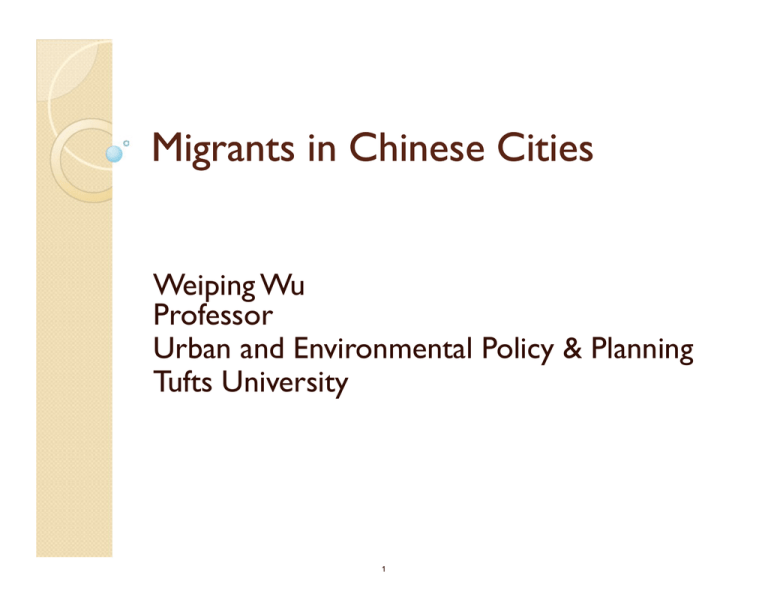Migrants in Chinese Cities Weiping Wu Professor Urban and Environmental Policy & Planning
advertisement

Migrants in Chinese Cities Weiping Wu Professor Urban and Environmental Policy & Planning Tufts University 1 Conceptualizing China China’’s migrants Separate urban and rural systems for ◦ Property rights ◦ Health care ◦ Welfare New developmental state – willing to break with previous policy of strict control Precarious position of migrants – their labor is desired but their presence unwanted Two kinds of citizenshipp ((urban and rural)) 2 Migrant ffeeatur atures es 200-250 million – primarily from rural to urban areas, and involves circular movements 70 ppercent is short-distance migration g (within province), and much inter-provincial migration originates from central and western regions and flows to coastal region. Concentrated among most economically active group (between the age of 15 and 34) – male migrants outnumber females (2 to 1) 3 nter--pr pro flows1995Inter ovincial flows1995 ws1995-2000 (Sourcce: Fan 2005) (Sour Image removed due to copyright restrictions. "Prominent Interprovincial Net Migration Flows, 1995–2000." Source: Figure 7 in Fan, C. C. "Interprovincial Migration, Population Redistribution, and Regional Development in China: 1990 and 2000 Census Comparisons." The Professional Geographer 57, no. 2 (2005): 295-311. 4 Migrant housing and settlement Proximity to employment and low costs are i important t t ffactors t iin residential id ti l d decisions ii Renters in general are more mobile than owners Mobility triggers – demand side (e.g. family status change, job change) and supply side ( (e.g. hhousing i opportunities) t iti ) Tenure shift – from rented rooms to selfbuilt shanties or houses, or from bridgeheaders to consolidators Spatial shift – from central city to urban periphery i h 5 Housing and welfare welfare we lfare Migrants Urban Rural Type of housing Private housing Own commercial housing Own economic and comfortable housing Own ppublic housingg Rent public housing Rent commercial housing Others Total Welfare Health insurance Retirement insurance Unemployment p y insurance 6 All Urban Locals Rural All 1.9 33.1 2.1 14.8 12.3 30.1 5.7 100.0 3.2 3.9 0.2 1.4 5.5 73.6 12.1 100.0 2.7 15.7 1.0 6.8 8.3 55.9 9.5 100.0 14.3 23.5 2.1 35.4 20.6 2.1 2.1 100.0 87.5 7.5 0.7 0.9 0.5 1.9 1.0 100.0 30.8 19.9 1.8 27.6 16.1 2.0 1.9 100.0 68.5 68.4 45.0 16.2 12.7 5.6 36.5 34.4 20.9 86.2 85.5 47.0 76.5 38.0 5.6 83.9 74.5 37.4 Photographs removed due to copyright restrictions. Survey sites in Beijing and Shanghai. Source: Figure 1 in Wu, Weiping. "Drifting and Getting Stuck: Migrants in Chinese Cities.”"City: Analysis of Urban Trends, Culture, Theory, Policy, Action 14, no. 1 (2010): 10-20. 7 Homeownership Homeownership Migrants (non-local) Rate of ownership Per capita housing (percent) area (m ( 2) Locals Rate of ownership Per capita housing (percent) area (m ( 2) 2005 Urban N SD 51.9 [[14618]] 50.0 25.3 [[14618]] 18.7 75.2 [[55784]] 43.2 25.8 [[55657]] 18.8 Rural N SD 8.7 [21407] 2.8 11.5 [21407] 11.6 96.6 [16212] 18.2 43.7 [16206] 30.8 All 26.3 [36025] 44.0 17.1 [36025] 16.4 80.0 [71996] 40.0 29.8 [71863] 23.3 1.9 [363] 9.5 [357] 30.6 [386] 17.1 [381] Rural N 0.4 [2357] 7.5 [2310] 87.6 [129] 33.5 [126] All 0.6 [2720] 7.8 [2667] 44.9 [515] 21.2 [507] N SD 1999/2000 Urban N N 8 Images removed due to copyright restrictions. Graphs of Average annual mobility rates over duration of residence in Beijing (2000) and Guangzhou (2005). Source: Figure 2 in Wu, Weiping. “Drifting and Getting Stuck: Migrants in Chinese Cities.” City: Analysis of Urban Trends, Culture, Theory, Policy, Action 14, no. 1 (2010): 10-20. 9 Spatial concentration Images removed due to copyright restrictions. Maps showing spatial concentration of migrant population and share of migrants in total population Source: unknown. 10 Context of China China’’ss urbanization Marketization – command to market economy Decentralization ece t a at o – central-local ce t a oca fiscal sca relations Industrialization – agricultural to manufacturing economy Migration – rural-based rural based to urban-based urban based society Globalization Gl b li ti – autarky t k to t open regime i 11 China China’ss urbanization at a glance ~1980 ~2010 % change Urbanization U b i i llevell (%) 19.4 19 4 51.0 51 0 162.9 162 9 Number of cities 193 657 240.4 Eastern region 69 344 398.6 Central region 84 218 159.5 Western region 40 95 137.5 Super large (> 2 million) - 42 Extra large (1-2 million) 13 82 530.8 L Large (0 5 -11 million) (0.5 ll ) 27 110 307 4 307.4 Small & medium (< 0.5 million) 153 423 176.5 Agriculture’s share in employment (%) 64 39 -39.1 Ratio of urban-rural per capita income 2.6 3.2 23.1 Cities bbyy population size 12 Urbanization and re regions Image removed due to copyright restrictions. Map of China showing urbanization and regions. Source unknown. 13 Resour Resource ce allocations b. Under market reform Central state a. Under state socialism Transfer Redistribution of investment Taxes Unified sale City Central state Taxes Tax collection Investment allocation Taxes Unified procurement procurement Provincial- or prefecturelevel city Unified sale County County-level city or urban district 14 Taxes & levies Unified procurement County y Urban administrative administrativehierar hierarch hierarchy chyy Central government Provinciallevel cities P i Provinces Counties Countylevel cities Towns & townships Urban subdistricts Urban districts Prefecturelevel cities Pref ectures Counties Towns & townships Countylevel cities Urban subdistricts Urban districts Counties Towns & townships Urban subdistricts The book The Chinese Cityy By Weiping Wu a Piper and pe Gaubat Gaubatz Routledge 2013, 9780-415-57575-1 16 Image removed due to copyright restrictions. Book cover photograph. Source: Wu, W., and P. Gaubatz. The Chinese City. Routledge 2013, 978-0-415-57575-1. http://www.routledge.com/books/details/9780415575751/ MIT OpenCourseWare http://ocw.mit.edu 11.S945 Urbanizing China: A Reflective Dialogue Fall 2013 For information about citing these materials or our Terms of Use, visit: http://ocw.mit.edu/terms.




